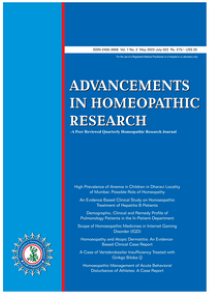High Prevalence of Anemia in Children in Dharavi Locality of Mumbai: Possible Role of Homeopathy
DOI:
https://doi.org/10.48165/ahr.2022.7.2.1Keywords:
Anemia, Dharavi, Children, Slum, Nutrition, IndiaAbstract
Background: Prevalence of Anemia is reported to be as high as about 90% in some segments of the population in India. Dharavi is arguably the largest slum in Asia. Due to its socioeconomic status, there is a possibility of malnutrition in this area. We have surveyed the area for the prevalence of anemia in Dharavi.
Methods: The status was assessed with the help of Local Laboratories at Dharavi. Children from 5 to 15 years of age were surveyed from 7 different areas of Dharavi. Their name, age, gender, contact number and the hemoglobin level were collected in the survey and analysed based on WHO criteria of mild (11 – 11.4 g/ dL), moderate (8.1 – 10.9 g/dL) and severe anemia (<8g/dL) in primary school-age children (5-11 years), middle-school-age childhood (12-14 years) and secondary school-age childhood (15 years).
Results & Discussion: There were 673 children surveyed. Kumbharwada had the highest number of subjects with 172 children. There were 380 male and 293 females. 324 children were from the primary school-age group, 255 from the middle-school-age group (12-14 years) and 94 from secondary school age childhood (15 years). Of the total 673 children, 363 children were non-anemic, and 310 children were anemic. There were 44, 91, and 41 children who were of mild anemic from the primary school-age group respectively, 77, 23and 16 children were moderate anemic from the middle-school-age group respectively, and 8, 6 and 4 children were severely anemic from the secondary school-age group respectively.
Conclusion: Dharavi, one of the most populated localities in the world, has a significant number of children with anemia. Homoeopathic can be a possible solution for the same in addition to the appropriate supplement.




